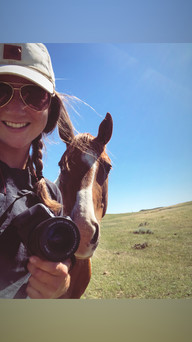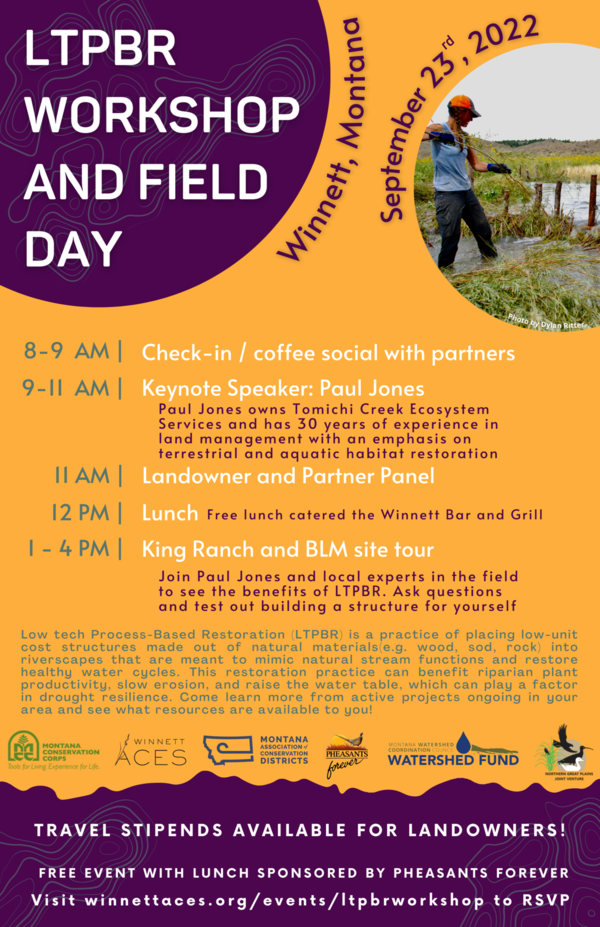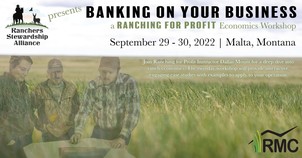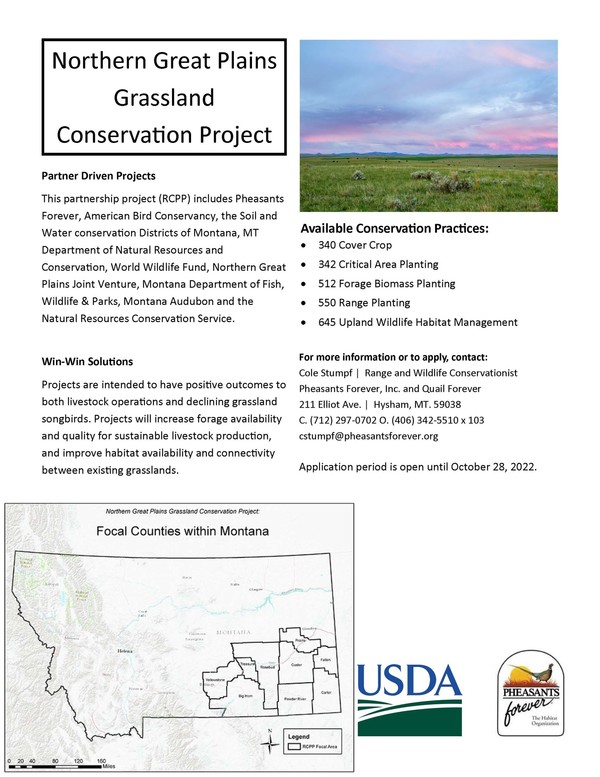
Internship Spotlight -Working Land Internship- Summer 2022 Autumn Grawe- in her own words
Over the summer I have been fortunate to experience five different cattle operations across Montana. Working for and learning from the Stevens’, Boyce’s, French’s, Indreland’s, and Smith’s has been truly eye-opening for me in understanding Montana agriculture and ranching.
At each ranch I went to, there were a variety of tasks I did. However, I learned that each ranch had a primary job that outweighed the hours put in other work. The first ranch I was at, the Stevens in Ashland, was branding a lot of calves yet, so I went to 4 or 5 of their family brandings to help. At the Boyce’s in Winifred, replacing fencing and working in the hops yard were the ongoing projects. My time was spent nearly 50/50 between the two, aside from when we took a day once a week to move cattle up Wolf Creek on horseback. At the French’s, there was a good amount of variety. I set up and took down a lot of electric fence, but also went to RSA meetings, built a chicken tractor, hauled bulls for testing, among other things. Then at the Indreland’s, I worked with the Quivira interns every day, moving a lot of electric fence and flood irrigating. Finally, at the Smith’s in Cohagen, we were on horseback frequently sorting drys or moving the cattle.
Over the entire internship, I enjoyed traveling to new places and meeting a lot of amazing people while learning about their ranching style. Some of my favorite things have been improving my horseback riding skills and learning the intricacies of grazing plans. I also enjoyed getting to fly in a two seater plane that was built and piloted by Bill Stevens. A bird’s eye view of the ranch is never a bad sight!
|


Barney Creek Livestock of Livingston in Park County is the 2022 recipient of the Montana Leopold Conservation Award®. See their inspiring story here.
Given in honor of renowned conservationist Aldo Leopold, the prestigious award recognizes farmers, ranchers and forestland owners who inspire others with their dedication to land, water and wildlife habitat management on private, working land.
As owners of Barney Creek Livestock, Pete and Meagan Lannan are cattle ranchers and land managers who are showing others how conservation practices can heal landscapes. The Lannans receive $10,000 and a crystal award for being selected.
Pete and Meagan Lannan are innovative ranchers who found a way to raise beef cattle amid exorbitant land values in Montana’s Paradise Valley. As owners of Barney Creek Livestock, they became land managers who show others how conservation can heal landscapes.
Their cattle and grass both thrived with a rotational grazing system, allowing the Lannans to increase stocking densities on their pastures. Pete and Meagan realized the more grass they could grow, the less hay they would need to harvest or buy. Since grazing year-round and stopping hay production in 2016, they only purchase the hay needed to feed during harsh winter storms. This change has saved them $120,000 in equipment depreciation, in addition to lower fuel and labor costs.
Each conservation success at the ranch inspired the Lannans to do more. They saw their cattle as a tool to help other landowners in Paradise Valley achieve soil health. They built relationships with owners of ungrazed and degraded properties by explaining how their stewardship could conserve and enhance natural resources.
|
|
A cool, wet late June and early July greatly improved drought across isolated parts of Montana, with notable precipitation winners and losers. Over the last month, south central Montana received the most rain, while the Golden Triangle and areas east to the Bearpaws and north to the Canadian border received variable and spotty precipitation.
Compared to last year at this time, the drought has improved. The below map shows changes in drought conditions over the last year. Most of the state has improved by multiple drought classes, but north central Montana has gotten drier, impacting agricultural producers - and others - in those communities.
The ongoing heat beginning in late July has been much above average and is predicted to continue through August, likely worsening drought where it persists.
The long range forecast currently indicates warmer and drier than normal conditions. Hopefully the trend will break in September and October. Fall rains in Montana are critical and are often a harbinger of moisture conditions the following spring and summer.
Agency Drought Updates
|
|
|
-
Crop yields are extremely variable across Montana: Many producers are seeing reductions of 30-50% or more, while some producers in eastern and south central Montana report record high yields.
- Statewide, crop yields this year are better than in 2021, except in the Golden Triangle where yields are worse.
-
Grasshopper hotspots exist statewide with Custer, Valley, Cascade, Teton, and Pondera counties all reporting extreme localized grasshopper populations.
|
|
|
|
- State-owned reservoir levels vary from above average to much below average. Irrigation on most projects is wrapping up for the season and dam tenders and water managers are looking to preserve reservoir pool levels in advance of the 2023 season.
- For state drought planning updates, visit mtdroughtinfo.org.
|
|
|
|
-
Harmful algal blooms (HABs) have been reported, especially in central and southcentral Montana reservoirs. Protect yourself, your family, your pets, and livestock - track and report HABs here.
|
|
|
|
|
Grazing: Governor appeals BLM's bison grazing lease.
Turf war [r20.rs6.net], Montana Free Press - Montana livestock-producer groups and two Republican elected officeholders continued their pressure campaign to halt bison grazing on federal lands late last week, asking the Bureau of Land Management to reconsider its recent approval of grazing leases in north-central Montana [r20.rs6.net]. In three separate appeals, the Montana Stockgrowers Association, Gov. Greg Gianforte and Attorney General Austin Knudsen asked the BLM to reverse its July 28 decision [r20.rs6.net] to approve American Prairie Reserve’s application to lease 63,000 acres of BLM-administered land in Phillips County. The appeals could slow the APR’s effort to grow its conservation herd of bison as part of its larger vision of “creating the largest wildlife reserve of its kind in the Lower 48 states” by stringing together public and private land.
The Winnett ACES has partnered with multiple local groups to bring a Low Tech Process-Based Restoration (LTPBR) Workshop to Winnett that is free and open to anyone. LTPBR is the practice of placing low-unit cost structures made out of natural materials (e.g. wood, sod, rock) into riverscapes that are meant to mimic natural stream functions and restore healthy water cycling. This restoration practice can benefit riparian plant productivity, slow erosion, and raise the water table which can play a factor in drought resilience.
On September 23rd, ACES will host a two-part workshop (classroom & field sessions) all about LTPBR and how it can benefit our communities. This is a great workshop for both landowners and partners like us that connect landowners to opportunities like these. Please RSVP here [events.eventzilla.net]

RESILIENT RANGE..
“There are no species in the desert that are still there that can't survive a drought,” Jack Alexander with Synergy Resource Solutions, Inc. points out with some hope. “This isn't the first drought, this isn't the last drought, this is just this drought.”
Alexander’s point serves as an important reminder that rangelands are adapted to drought, have survived it in the past, and will continue to withstand drought in the future. That’s not to say drought is a light topic amongst range managers, but if the land has been well cared for leading up to a drought, the impacts will be less severe, and recovery will be easier.
“If you've taken care of those plants to where they have healthy underground root systems, the tops are going to get hurt by the drought, but that underground root system is good at going dormant, it’s good at avoiding the drought,” he said. “Often the way they avoid the drought is they act dead, they play possum, and just come up and they go, ‘we've seen it this dry before, I'm done spending carbohydrates until I get wet.”
 |
At the core of the mission behind Good Grazing Makes Cent$ is facilitating "conversation and collaboration between range scientists and ranchers." As a key program driver, we aim to create conversation in multiple ways to ensure that our members feel their questions are being answered.
Wondering how you can take advantage of the tailored content?
1. Tune in to live events.
2. Submit your question to our list of experts.
3. Join the Facebook discussion.
Submit a Question to GGMC Experts
Read the Full Issue
Western Sustainability Exchange Sponsors Expanding Livestock Markets Conference
Expanding Livestock Markets Conference
If you could learn from successful regenerative ranchers and progressive companies about how to increase your bottom line, would you? Join WSE to learn how you can work with nature to lower your input costs, become a more productive ranch, and receive a premium for your products! Hear from all sides--aggregate supply chain companies, verifying organizations, value-added companies, and successful regenerative ranchers taking advantage of innovative marketing opportunities.
The conference will take place September 15th and 16th from 10:00 am to 5:00pm at the Pine Meadows Golf Course, Lewistown, MT.
The conference in $75/person and the last day to register is August 31st.
Register here!

Change the Conversation from Productivity to Profitability… Attend the Ranching for Profit Workshop in Malta, Montana, September 29-30
“Agriculture is more productive than we have ever been. However, on average our farms and ranches are no more profitable than they have ever been,” Dallas Mount wrote in a recent blog titled, “Productive But Not Profitable.”
Perhaps this is due to the strong and successful message that agriculture must become more productive to meet the demands of the population, but Mount suggested the focus has been placed on the wrong aspect. In fact, as agriculture has increased its productivity, the reality is that “most farms and ranches operate at a loss more often than they make a profit,” Mount wrote.
“Let’s change the business conversation in agriculture away from the largely meaningless metrics of productivity and towards the important metrics of profitability,” he concluded.
His upcoming workshop schedule includes Ranchers Stewardship Alliance’s (RSA) “Banking on your Business – a Ranching for Profit Economics Workshop” in Malta, Montana on September 29-30, 2022. The two-day workshop features a condensed and higher-level overview of the topics covered in the full Ranching for Profit School and participants will leave with a better understanding of how to evaluate ranch decisions from an economic perspective. Some of the topics covered will include economics versus finance; understanding overheads and direct costs; ranch enterprise analysis; understanding gross margin and applying it to decisions; developing an economic plan; and testing the plan for financial feasibility.
This workshop is being brought to the community from the Rancher’s Stewardship Alliance Beginning Rancher and Education committees. For more information visit the registration page or follow Ranchers Stewardship Alliance on Facebook and Instagram for updates.
Workshop Registration [ranchstewards.us8.list-manage.com]
|
 |
The Economic Cost of Noxious Weeds on Montana Grazing Lands
Invasions by exotic species have been cited as one of the leading causes of environmental change and decreases in biodiversity, it is estimated that nonindigenous species in the United States cause damages of $137 billion annually, with nonnative plants making up $34 billion of that cost.
On rangelands, these economic impacts are associated with livestock production; in particular, noxious weeds reduce yield and quality of forage and can poison livestock. In addition, landowners incur expenses when they implement noxious weed management strategies aimed at limiting weed invasions or managing current infestations . Overall, reductions in rangeland carrying capacity for livestock and increases in operating and management costs lead to reduced land value.
Read the scientific article!

DNRC has finalized the Flood Response Irrigation Grant Application Guidelines
Governor Gianforte and the Infrastructure Advisory Commission have prioritized $1.2 million to help irrigators recover from flooding damages sustained during the Spring of 2022. Grant limits are set at $250,000 per project and applications will be considered on a "first come, first serve" basis. These grants must be for agricultural irrigation projects that are eligible for ARPA Water and Sewer Funds.
Visit the Flood Response: Irrigation Grant Program website for more information and updates.

FWP Seeks Public Input on Revisions to Elk Management Plan
FWP is seeking input on the existing elk population objectives and local elk management challenges that should be considered in the revision. The scoping period started several weeks ago, but meetings have been sparsely attended and FWP has received few comments to date.
FWP will be hosting a series of public meetings this summer and fall to gather ideas about local elk management issues and population objectives. See meeting schedule, or see the 'Save the Date' section, below.
Information on current elk population objectives being considered for revision can be viewed here. FWP would like feedback on relative population objectives as well as individual hunting districts.
The deadline for public comment is October 15, 2022.
FWP director, deputy director and staff to host open houses around state
HELENA – Montana Fish, Wildlife & Parks director, deputy director and members of their staff will be visiting regional offices during a tour of the state in August and September. Director Hank Worsech and Deputy Director Dustin Temple invite the public to participate in the tour and to ask questions during evening open houses.
All meetings begin at 6 p.m. The schedule is as follows:
Sept. 6: Region 1 Headquarters in Kalispell, 490 North Meridian Road
Sept. 7: Region 2 Headquarters in Missoula, 3201 Spurgin Road
Sept. 8: Region 4 Headquarters in Great Falls, 4600 Giant Springs Road
Sept. 14: Region 5 Headquarters in Billings, 2300 Lake Elmo Drive
Sept. 15: Region 3 Headquarters in Bozeman, 1400 South 19th
This is the second time Worsech and Temple have traveled around the state to hear from the public. The feedback from the first round of visits has helped influence FWP’s approach to elk management, hunting regulations, and public engagement.
The format of the meetings will be fairly open and so the public can ask any questions they’d like.
FWP ensures its meetings are fully accessible to those with special needs. To request arrangements, call FWP at 406-444-3186.

The Fall 2022 Bair Ranch Foundation Seminar Series brings nationally recognized scientists and agricultural professionals to Montana State University for the benefit of students, faculty and the public. The series aims to foster greater public engagement and outreach on innovative research, and highlight agricultural and natural resource issues.
Please feel free to join in person or via WEBEX! Information and schedule can be found here:
http://animalrange.montana.edu/bairranchfoundation.html [animalrange.montana.edu]

Soil Health is Key to a Healthy Planet
Healthy soil gives us clean air and water, bountiful crops and forests, productive grazing lands, diverse wildlife, and beautiful landscapes. Thanks to the soil professionals, farmers and growers conserving our soil and improving our global soil health.
Learn more about the ABCs of Soil Health.

The Art of Range
Intro to Ranch Financial Resiliency--Jack Southworth, James Rogers, & Clay Worden
This month's Podcast Corner features the Art of Range. The Art of Range podcast provides education through conversation with some of the brightest minds in rangeland management and livestock production.
Many ranchers don't do it for the money, but one cannot ranch for long only losing money. In this first episode in a grant-funded series on ranch financial resiliency, Jack Southworth discusses principles and common problems in ranch money management with James Rogers and Clay Worden.
Washington State University rangelands and livestock specialist Tip Hudson interviews researchers, ranchers, and resource professionals to bring you extended discussion on topics that are of interest to anyone in rangelands work. A new episode releases every two weeks.
Watch here!
|
MSU Extension:
Updated MontGuides
University of Montana:
Rangeland Analysis Platform
Reversing Tree Encroachment Increases Usable Space for Sage-Grouse during the Breeding Season
USDA-Agricultural Research Service
Scientific Discoveries 2022
Rangeland Resources & Systems Research, Fort Collins, CO:
Livestock and Range Research Laboratory, Miles City, MT:
Pest Management Research, Sidney, MT:
USDA- Wildlife Services:
US Forest Service Research & Development:
Research topic: Fire
Research topic: Water, Air, & Soil
September 2022:
October 2022
Stacey Barta, State Coordinator for Rangelands
(406) 594-8481
SBarta@mt.gov
Rangeland Resources Committee:
Diane Ahlgren, Chair
John Hollenback, Vice Chair
Sigurd Jensen
Jim Anderson
Leah Lewis
Ron Devlin
|